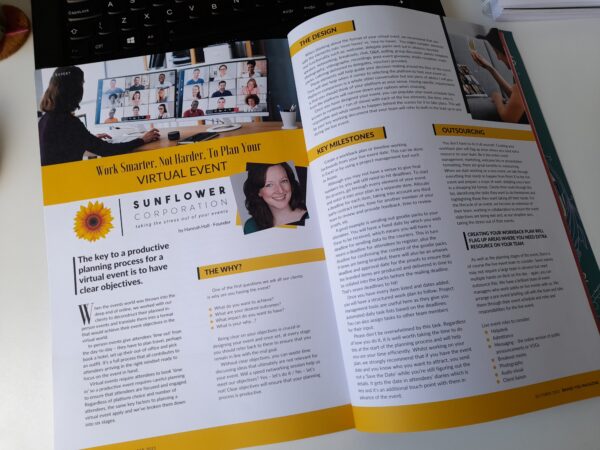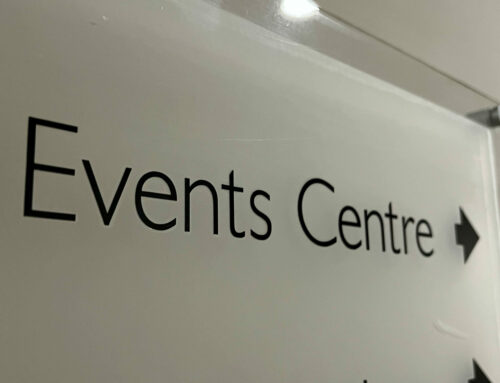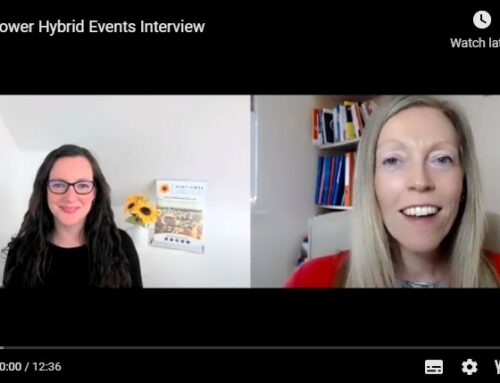This article originally appeared in the October 2021 edition of Brand You magazine as an interview with Hannah Hall, Sunflower’s founder.

The key to a productive planning process for a virtual event is to have clear objectives.
When the events world was thrown into the deep end of online in March 2020, Sunflower Event Team worked with our clients to deconstruct their planned in-person events and translate them into a format that would achieve their event objectives in the virtual world.
In-person events give attendees ‘time out’ from the day-to-day – they have to plan travel, perhaps book a hotel, set their out-of-office, pick an outfit, a full process that all contributes to attendees arriving in the right mindset ready to focus on the event in hand.
Virtual events require attendees to book ‘time in’ so a productive event requires careful planning to ensure attendees are focussed and engaged.
Regardless of platform choice and number of attendees, the same key factors to planning a virtual event apply and we’ve broken this down into six stages.
1. The why?
One of the first questions we ask all our clients is: why are you having this event?
- What do you want to achieve?
- What are your desired outcomes?
- What impact do you want to have?
- What is your why…?
Being clear on your objectives is crucial in designing your event. Once set, at every stage you should refer back to them to ensure that you remain in line with the end goal.
Without clear objectives, you can waste time discussing ideas that ultimately are not relevant for your event. Will a speed networking session help us meet our objectives? Yes – let’s do it / No – let’s not! Clear objectives will ensure that your planning process is productive.
2. The design
When thinking about the format of your virtual event, we recommend that you split the elements into ‘must have’ vs ‘nice to have’.
You might consider elements and functionality such as:
- Welcome
- Delegate packs sent out in advance
- Welcome
- Key note
- Networking
- Breakouts
- Chat
- Q&A
- Polling
- Group discussion
- Panels
- Helpdesk
- Photography
- Videography
- Recordings
- Post-event giveaway
- Drinks reception
- Snack packs / catering delivered to delegates / vouchers provided
These elements will help guide your decision making on the flow of the event. They will also help when it comes to selecting the platform to host your event on. Platform comparison is a whole other conversation but one piece of advice we would give is to think of your platform as your venue. Having specific requirements from the platform will narrow down your options when choosing.
Once you have designed your event, you can populate your event schedule (also known as runbook / run of show) with each of the live elements, the time, who is responsible and what needs to happen behind the scenes for it to take place. This will be your key working document that your team will refer to both in the lead up to and during the live event.

3. Key milestones
Create a workback plan or timeline working backwards from your live event date. This can be done in Excel or by using a project management tool such as Asana.
Although you may not have a venue to give final numbers to, you will still need to hit deadlines. To start the process, go through every element of your event and enter it into your plan as a separate item. Allocate a deadline for each item taking into account any third-party contract terms, time for another member of your team to review and provide feedback, time to review proofs etc.
An example is sending out goodie packs to your attendees. You will of course have a fixed date by which you wish these to be received, which means you will have a deadline for sending address data to the couriers. This is turn means a deadline for attendees to register by, plus the deadline for confirming the content of the goodie packs. If items are being branded, there will also be an artwork deadline and approval date for the proofs, to ensure that the branded items are produced and delivered in time to be collated into the packs before the mailing deadline. That’s seven deadlines to hit!
Once you have every item listed and dates added, you will have a structured work plan to follow. Project management tools are useful here as they give you automated daily task lists based on the deadlines. You can also assign tasks to other team members for their input.
Please don’t be overwhelmed by this task. Regardless of how you do it, it is well worth taking the time at the start of the planning process as it will help you use your time efficiently. While working on your plan, we strongly recommend that if you have the event date and you know who you want to attract, you send out a Save the Date while you are still figuring out the details. It gets the date in people’s diaries which is key, and it’s an additional touch point with them in advance of the event.
4. Outsourcing
You don’t have to do it all yourself!
Creating your workback plan will flag up areas where you need extra resource on your team.
Be it the entire event management, marketing, welcome kits or presentation formatting, there are great benefits to outsourcing.
When we start working on a new event, we talk through everything that needs to happen from Point X to the live event and prepare a scope of work detailing every item in ‘shopping list’ format. Clients then work through the list identifying the tasks they want to do themselves and highlighting those they want taking off their hands. For the lifecycle of an event we become an extension of their team working with in collaboration to ensure the event objectives are being met and, as our strapline says – taking the stress out of their events.
As well as the planning stages of the event, there is of course the live event team to consider. Some events may not require a large team in advance but need multiple ‘hands on deck’ on the day – again you can outsource this. We have a brilliant team of event managers who work solely on our live events with us. We plan in a pre-event briefing call with the team and take them through their event schedule and roles and responsibilities for the live event.
Live event roles to consider:
- Helpdesk
- Admitting
- Messaging – the online version of public announcements or VOGs
- Breakout rooms
- Photography
- Audio Visual
- Client liaison

5. Live event & troubleshooting
Start the day early with a team briefing, then it’s time to go live!
Everyone has their role to cover and – although everything is detailed in the event schedule – you will need to have a way of communicating such as WhatsApp. Think of this as the alternative to radios at an in-person event for behind-the-scenes questions / decision making / firefighting.
Ensure you have separate chats / channels set up in your preferred method of communication for the client and for your team. In the same way as you would have radio etiquette at an in-person event, you will need to give guidelines as to how you wish the team to use the comms in place. For example, if you have a question for a specific person @name them so that everyone knows who is to answer the question but others can also see the answer in case it is useful to them.
In the UK you would never run an outdoor event without a wet weather plan; in the same vein you should never run an online event without some contingency planning. Identify in advance who steps in if the keynote speaker loses connection and what the chain of communication is if there’s an issue with the platform. Have a catch-all broadcast that can go out in the chat or over audio in the event of something not working properly so that your audience knows that you are dealing with it.
When the event comes to a close, be sure to gather your team online for a quick thank you. The end to an online event can be very abrupt as the host clicks the ‘end’ button so the value in spending 5 – 10 minutes bringing your team together in the virtual world is huge.
Apps for team comms during the live event
- Discord
- Slack
- Teams
6. Post-event & automation
Just as pre-event comms are important for engaging attendees, so too should be your post-event follow-up. With no opportunity to continue discussions in person / grab a coffee and network at the end of an event your follow-up becomes an even more important touch point than in pre-Covid times.
Be it a thank you email / survey / further information, we recommend that you automate follow-up emails to go out to both attendees and no-shows. We recently ran an event where the keynote speaker was an author, so all those who attended received a copy of their book the day after the event with a handwritten ‘thank you’ note for attending! It was not only a nice surprise for them but also gives a tangible follow-up with our client’s branding on it that will now sit in their office / home.
You could also consider automating an ‘it’s not too late to join us’ email to go out to no-shows on the live event day, once it is underway.
Finally, for your refence review the event, reflect on what worked / what could be improved, refine your plan for next time. Pull any relevant questions that came out of your team channel into an FAQs document ready for future use. This part of the process will ensure an even more efficiently run event next time.
In conclusion, please don’t underestimate the time that planning and executing a successful event can take. Make sure you have clear objectives for delivering the event and refer back to them throughout the planning process.
***
Brand You magazine
www.instagram.com/brandyou_magazine
Brand You is a monthly magazine for female entrepreneurs, containing practical tips and advice on how to create an extraordinary brand and business. There’s inspiration from incredible women all over the world, methods to help you create, grow and manage your perfect business to stories of other female entrepreneurs, so you can learn from their mistakes and mirror their success.
brandyoumagazine.co.uk






